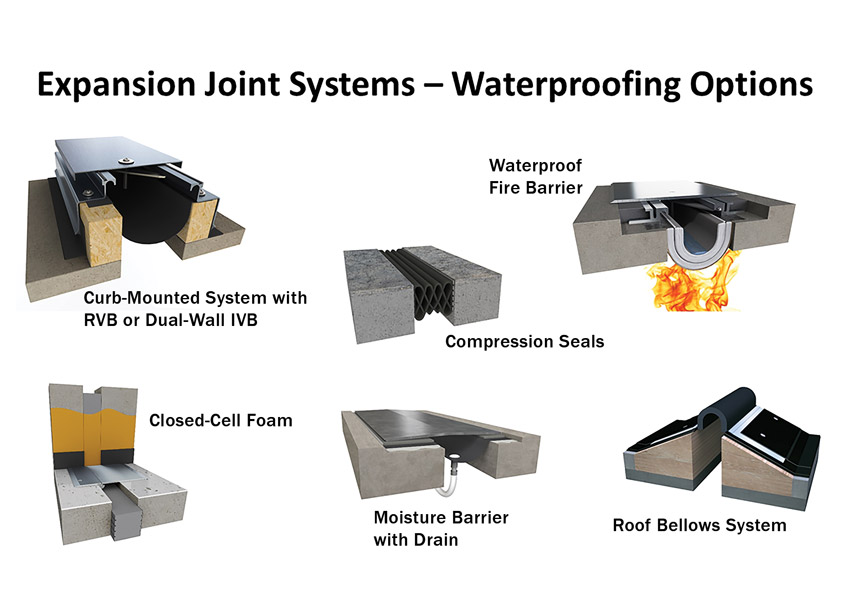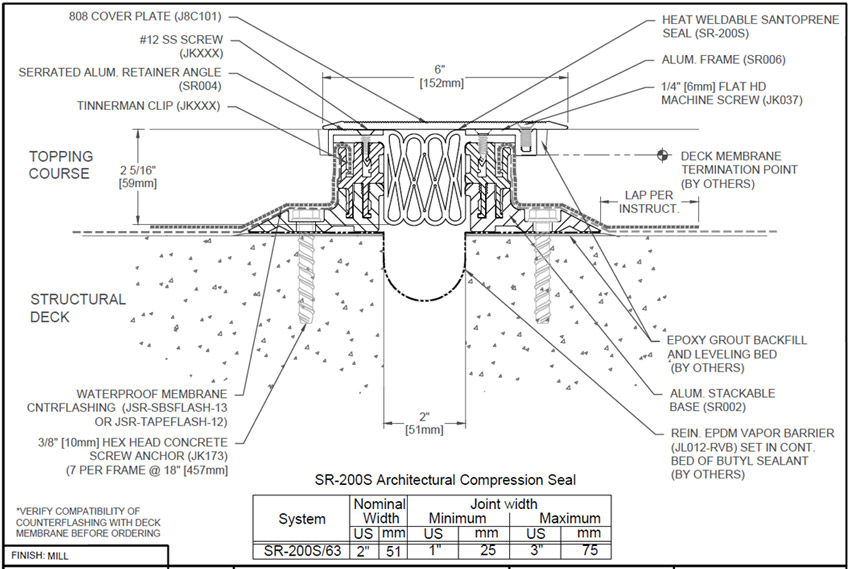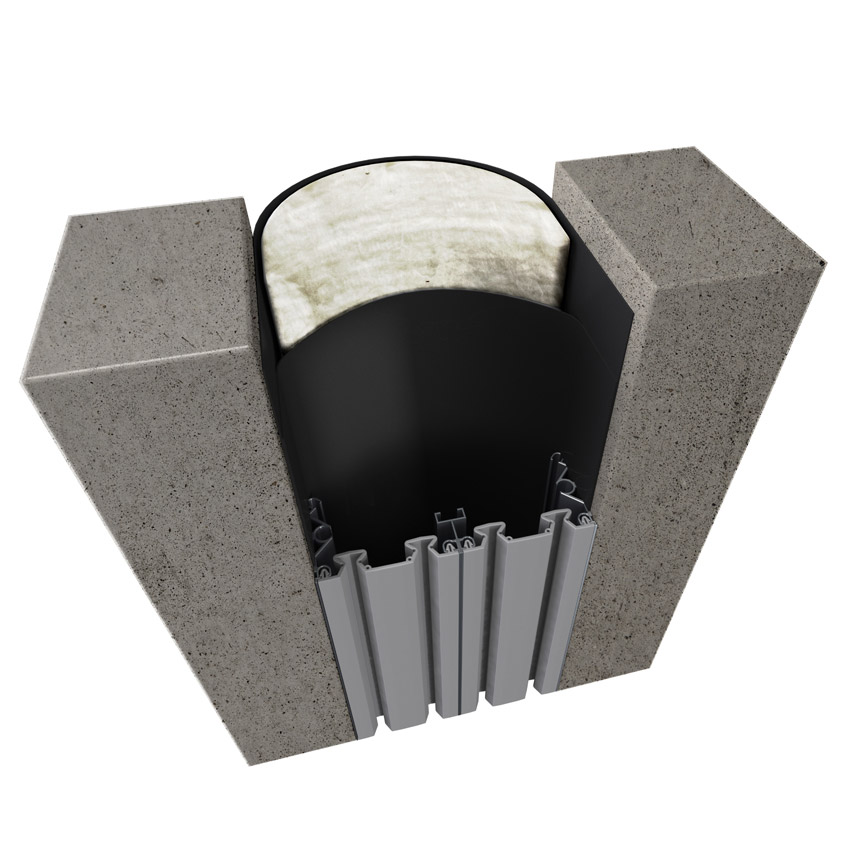High-Performance Thermal and Moisture Protection Strategies
Addressing Details: Expansion Joints
Controlling thermal energy and moisture in buildings is clearly a multifaceted task, although it is fairly straightforward to comprehend when we are talking about the middle or primary areas of walls, roofs, etc. It is critically important, however, to pay attention to the detail areas. On larger buildings, expansion joints are one of those crucial details since they represent an intentional break in the structure to allow for the movement of different parts of the building due to thermal expansion and contraction, seismic loads, or other conditions. Since those expansion joints typically interrupt the thermal, moisture, and air barriers in a building, how they are treated and addressed will determine the continuity, or not, of these barriers across the expansion joints.
Different types of buildings will utilize expansion joints in different locations and in different ways. Some may use them on exterior roof or pedestrian decks in a horizontal location. Others may incorporate them into walls in a vertical fashion. Some may be connected to concrete structures, others to steel, or some to a hybrid system. Either way, they all will incorporate a gap that needs to be filled with some sort of expandable material that is appropriately secured to each side of the gap. Depending on the durability and the appearance of that filler material, they may then be left exposed or covered over with a metal cover system. From the standpoint of thermal and moisture protection, the key to successfully maintaining the needed barriers often comes down to the selection of the material or type of system used to fill the gap in the expansion joint. We will look at some of the more common choices below and comment on their suitability for different building applications.

Images courtesy of Inpro
Expansion joint materials and systems come in many types and configurations. Selecting the appropriate ones for any given building project not only helps maintain the structural integrity of the building, but it also helps assure that the continuity of thermal and moisture barriers is maintained.
Closed-cell foams. Closed-cell foams are very watertight and do not allow the moisture to enter the body of the foam. This is the best application for horizontal runs where water could pool. These are tougher to compress but can be placed under tension or pulled to expand quite well. The other key advantage of closed-cell foams is that they take well to heat-welding of seams. This renders a monolithic installation that reduces the risk of water infiltration.
A good rule of thumb/best practice when using closed-cell foam seals is to limit their application with a joint width of no more than 8 inches (200 millimeters) or smaller. Use of foams for expansion joints larger than 8 inches leads to two things:
- Exceeding the foam’s performance characteristics. Plus, the weight of “super-wide” foam seals can lead to sagging in vertical applications.
- Dramatically higher costs compared to other expansion joint cover solutions, such as a four-component system with face seal, rails, and back seal.
Open-cell foams. Yes, these products do allow for some flow-through of water vapor. Like many exterior veneer systems, if moisture becomes trapped in a wall cavity, building systems allow the moisture to wick out. This is a good quality and a major focus to eliminate potential mold issues in vertical applications. Hence, open-cell foams should be employed only in vertical installations, where gravity can wick any absorbed water downward and away from the building enclosure.
Architects should also be aware that open-cell foams for expansion joints come in a maximum lengths of 5 feet, and because they are not heat-weldable, caulk must be used at the seams. This can introduce a future failure point as well as higher periodic inspection and maintenance costs should the seams need to be repeatedly re-caulked to prevent leakage. It’s also important to know that while in a compressed state all foams may look the same, they are not. Specifications calling for foam seals made with “monolithic manufacturing methods” will help avoid product failures and claims down the road. Architects should look closely at the seal’s construction and ask questions of the manufacturer as to the seal’s makeup and the watertightness of seams.
Waxed vs. wax-free foam. Heavy wax-impregnated foams that help keep joints watertight have been in use for about 50 years. However, some consider the addition of copious amounts of wax old fashioned, which may be true up to a point. Today, a 2–3 percent wax impregnation is generally viewed as the best alternative since it drastically increases the hydrophobic properties of the foam and extends the seal’s lifespan.
So what if the specifier chooses to forego wax impregnation? Plain foam can act just like a sponge. In addition, plain foam assumes an unrealistic expectation of perfect installation of the silicone face in manufacturing and field perimeter caulk seals to keep the foam protected. If the face silicone seal itself is damaged—say, by the tip of a caulk gun jammed between the foam and wall or deck material—leaks will likely occur. With wax impregnation, the foam seal will remain watertight even if the silicone face seal is compromised, primarily because wax doesn’t dry out.
Compression seals. As their name implies, compression seal joint systems are installed into a blocked-out joint area and absorb movement and flexing through compression and expansion of the seal. The rubber-looking, corrugated joint material is also an excellent option for exterior application where waterproofing is required. These seals are best employed for heavy pedestrian and moderate vehicle loading. Proper use of two-part epoxies ensure solid adhesion to the deck, and heat-welded seams ensure watertight performance. The nominal joint width for these systems should not exceed 3½–43⁄8 inches (89–111 millimeters) since the material can’t really handle wider applications than that. Since these are often left exposed, building aesthetics can be enhanced through the use of colored compression seals.
Hybrid compression seal systems. It is important to note that expansion joint systems with tied-in waterproofing is critical to avoid water infiltration into adjacent spaces. A new hybrid design of compression seal system is delivering a greater level of waterproofing in split slab construction. The key benefit of this system is in the integrated counterflashing that is employed, which is engineered to channel water away from the joint opening. Note that it is vital that the counterflashing be compatible with the adjacent materials and adhesives being used. Failures in waterproofing can occur if the flashing fails to adhere or reacts to the adhesive. Where load factors require it, metal cover plates can be added over the top of the seal.

Image courtesy of Inpro
A detail of a hybrid expansion joint shows the concrete gap, the compression seal, the tie-in with a waterproofing system to create continuity, and a metal cap for protection from imposed loads.
Reinforced vapor barrier seals. One solution that can be used in certain applications is to employ a reinforced vapor barrier (RVB) to prevent water infiltration or to channel water to drain locations via an integrated drain tube. The critical factor in installation of an RVB expansion joint system for waterproofing is to apply a bed of manufacturer-approved butyl sealant in the concrete block-out area or along the frame along the entire length of the expansion joint. This will aid in securing the moisture barrier to the concrete block-out and provide a watertight seal to prevent seepage around the perimeter of the joint. In order to work properly, always leave enough drape in the moisture barrier to ensure the system will be able to fully open to its maximum distance without interference from the expansion cover components.
Roof bellows systems. Roofing expansion joint systems use either an EPDM or a neoprene seal that flexes in the manner of a bellows to accommodate seismic movement. As with counterflashing, the seal must run under the metal flanges to allow water to be shed away from the joint opening. Also, a compatible, nonreacting mastic should be used to ensure watertight adhesion of the seal.
When detailing roofing systems, don’t forget the transitions. Tying in horizontal and vertical joint systems requires transition covers to help maintain watertightness. Transition areas include intersections where different roof bellows meet or cross and joints that turn up or down as they transition along horizontal to vertical surfaces. While we would like to think that architectural drawings and details always cover this, the reality is that sometimes transition covers and tie-ins are missed.
Thermal migration. Expansion joint thermal performance is often overlooked in building design, but is no less important than air and moisture performance. Most designers consider the RVB as the go-to-standard within expansion joints. RVBs are a durable membrane that resides within the joint. They accommodate movement but also prevent the penetration of air, debris, and pests from entering through the joint. There is some minor insulating benefit from RVB joint systems, but an insulted vapor barrier (IVB) should be considered wherever thermal performance is important. The addition of insulation within the dual-walled vapor provides a higher R-value—and the benefit, of course, is that the R Value works in both directions—heat or cold don’t penetrate the joint, and interior occupant comfort and HVAC performance are better shielded from the outside conditions along the entire length of the joint.

Image courtesy of Inpro
An insulated vapor barrier expansion joint system includes flexible insulation between an inner and outer vapor layer, providing complete thermal and moisture protection along the entire length of the expansion joint.
There are clearly numerous systems and products available when considering maintaining water, air, and thermal resistance along expansion joints. While some may say only foam, recognize that foam can be one of the most expensive products to use in some situations. And as we’ve seen, there are other better alternatives in many applications.
Notice

www.inprocorp.com

www.kingspaninsulation.us

www.tamlyn.com









